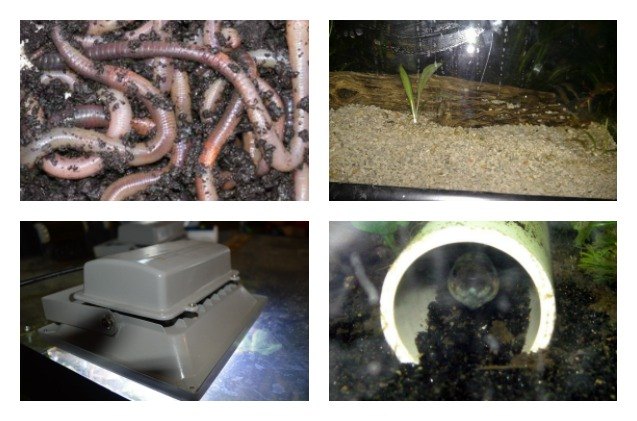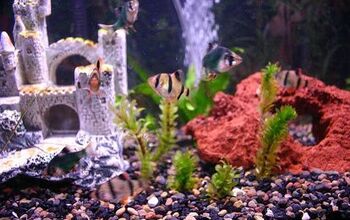Cost-Cutting Tips and Tricks for Aquarium Enthusiasts

When first starting out in the aquarium hobby, it’s easy to become overwhelmed by the amount of products that are available on the market. It’s also easy to spend half of your paycheck, and still not feel like you have everything you need. There are a few tricks that experienced aquarists use to cut down on the amount of money spent, especially if you’re keeping multiple tanks at once.
Filters
Sponge filters are one way to cut down on the cost of filtering your tank. A sponge filter is designed to be a biological filter that will pick up the mulm, debris, and waste in the water. Sponge filters, depending on the type, size, and quality, will cost between $5 and $25. Sponge filters are readily available through most major aquatic supply retailers, and are also relatively easy to make on your own using a piece of PVC pipe, sponge, and a ceramic tile. All sponge filters are run on air, and you may be thinking about the expense of getting multiple air pumps, however there are industrial pumps that are available and will run many sponge filters using airline tubing and gang valves.
Related: 6 Popular Aquarium Fish You Need To Avoid
Fish Food
Another way to cut down on costs is to find your own fish foods. Most fish will enjoy earthworms, flies, or mosquito larvae, all of which can usually be found no further than your own backyard. Take care when coming in contact with all bugs and creepy crawlies, but particularly with mosquito larvae. Make sure there’s no stagnant water nearby to where you, or your children and pets are, due to risks of west Nile virus and other mosquito-borne diseases.
Many fish keepers also keep cultures of various types of foods, including things such as white worms, grindal worms, black worms, and fruit fly larvae. Hatching your own baby brine shrimp is also common practice in the hobby, especially for those who have fry (baby fish) in their tanks.
Related: Take a Walk On the Wild Side of Bettas
Lighting
Lighting is typically on of the more expensive costs up front when setting up a new tank. Fixtures can vary in price, but easily reach hundreds of dollars, especially if they have different light settings, colors, etc. A cheap and effective way to cut back on lighting costs is to use a simple shop light fixture that can be found at any hardware store. There are even plant specific bulbs for these fixtures, for those who are growing live plants. Another option is an LED flood light, which not only is inexpensive but uses little power.
Substrate
Substrate is another area where costs can be trimmed. There are a lot of inexpensive options when it comes to what lays on the bottom of your tank. Sand is a popular choice, and a quick trip to the local hardware store can supply you with everything that you need. Children’s play sand, pool filter sand, and blasting sand will all work wonderfully for tanks; just be sure to rinse them first. Another option is the same stuff that mechanics use to soak up spills in garages. Some call it kitty litter, others call it oil-dri, but it is essentially a clay based rock looking substrate.
Tank Decor
Decor within a tank is also easy to get for a low price. Terra cotta flower pots (whole or cut in half), PVC pipe pieces, and wood and rock found outside all make wonderful additions to your tank, without breaking the bank. Most decor, especially natural looking, can be found just be searching in the woods or around a local river, lake, or pond. It is important with both wood, and rocks, to dry them thoroughly, and then boil to remove any parasites that may be hiding. Wood should be dead, bark removed, and made of hard wood that will not rot in water. Rocks should be tested with vinegar to see if they will affect the water parameters within your tank.
Over all, many aquarium projects can be fun and easy to do yourself, and will save you some coin. Be creative, search the Internet and YouTube for ideas, and put your own spin on these projects. As long as all materials used are aquarium safe, your projects will last a long time and be rewarding.
Summer Davis is the mom of three kids, four dogs, and several tanks of fish. She boasts a passion for all animals, whether they are in the water or on land. This fish aficionado has kept many different species in her time, but holds a special place in her heart for wild and domestic bettas. When she’s not talking about fish, Summer “spins” her extra time as the director of a baton twirling organization.

Summer Davis is the mom of three kids, four dogs, and several tanks of fish. She boasts a passion for all animals, whether they are in the water or on land. This fish aficionado has kept many different species in her time, but holds a special place in her heart for wild and domestic bettas. When she's not talking about fish, Summer "spins" her extra time as the director of a baton twirling organization."
More by Summer Davis
























